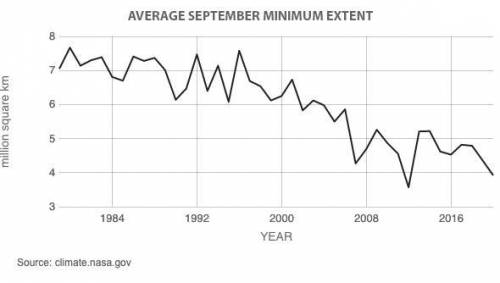
Biology, 02.12.2021 21:50 reggie1127
Arctic sea ice melts back during summer and grows or "recovers" during winter. The winter maximum extent is usually reached in March. The graph below shows Arctic sea ice extent every September since 1984.
Which statement best describes how evidence of Arctic ice melt changed over time?
- The Arctic ice has decreased three million square kilometers in 32 years.
- Arctic ice extent in the year 2016 is equal to Arctic ice extent in 1984.
- Arctic ice extent is lowest in September 2016 and highest in 1984.
- The Arctic ice extent was highest between 2000 and 2016.


Answers: 1


Another question on Biology

Biology, 21.06.2019 19:30
Which statement best describes a keystone species? o a. it has littlelmenetic variation. it has an extremely high population. 0 b. 0 c. it remains unaffected by all environmental changes. od. it has a strong influence on the ecosystem. 0 e. it's the first species to populate a new ecosystem.
Answers: 2

Biology, 22.06.2019 04:00
Select the correct answer. which mutation is harmful to the organism? a. a mutation allowing moths to camouflage better on blackened tree bark b. a mutation making staphylococcus aureus resistant to the antibiotic methicillin c. a mutation inhibiting human immunodeficiency virus from attaching to and entering the cell d. a mutation causing uncontrolled cell division e. a mutation giving plant leaves a bitter taste to discourage herbivores from eating them
Answers: 1

Biology, 22.06.2019 05:30
Which statement describe events that occur during interphase?
Answers: 2

Biology, 22.06.2019 07:00
Which of the following statements is most likely correct about a rock belonging to the jurassic age and a rock belonging to the cambrian age? options: 1) they have identical fossils of organisms that have evolved over time. 2) both have animal fossils preserved in them due to weathering and erosion. 3) they contain different fossils because life on earth has changed through time. 4) the fossils in them were formed on the surface of earth due to exposure to sunlight.
Answers: 1
You know the right answer?
Arctic sea ice melts back during summer and grows or "recovers" during winter. The winter maximum ex...
Questions






















